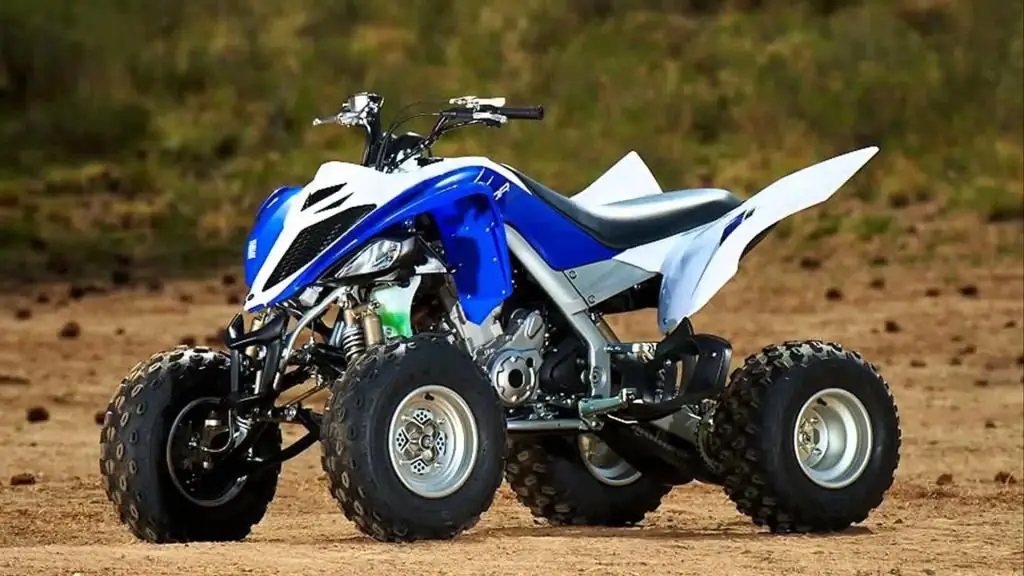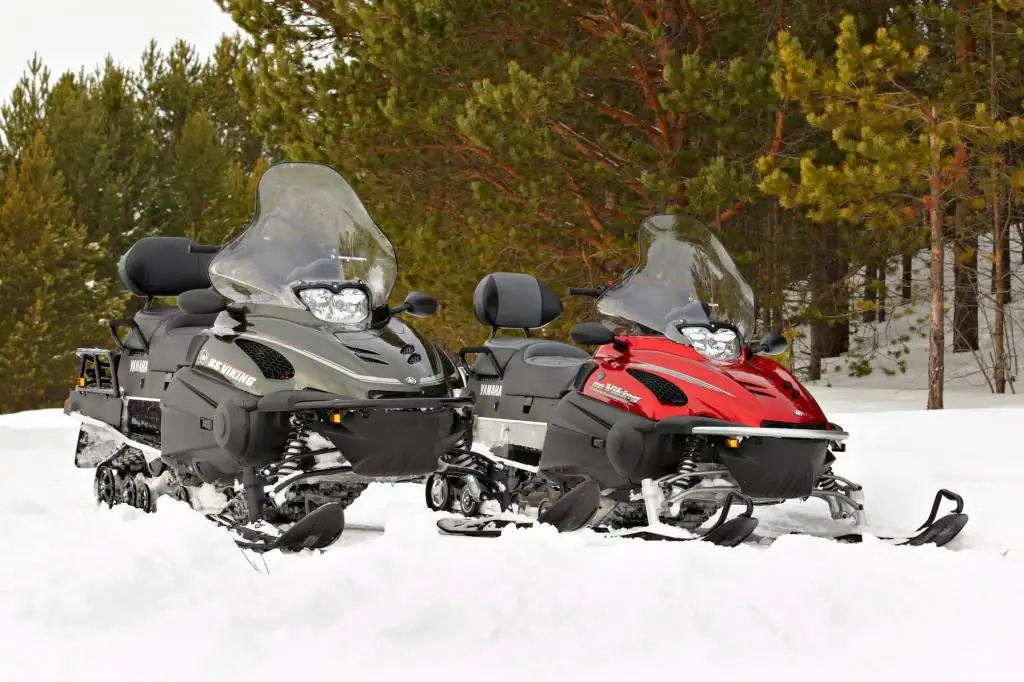2025 Author: Erin Ralphs | [email protected]. Last modified: 2025-06-01 05:35:55
The FZR-1000 is the motorcycle that contributed greatly to the next generation of Yamaha superbikes: the YZF 1000 Thunderace and the YZF R1. In the early 90s, he became a legend, they ride him and still love him.
Motorcycle of the Decade
The superbike that propelled Yamaha to the forefront of sporty design was released in 1987 as the Yamaha FZR 1000. At that time, the machine reached a top speed of over 250 km/h, and the 1989 modification, named the motorcycle of the decade, could accelerate to 100 km/h in less than 3 s. Its maximum speed exceeded 270 km / h. With these features, any bike would be in high demand, so production continued.

In 1989, the manufacturer improved the performance of the Yamaha FZR 1000 by increasing the engine displacement to 1002cc3 and adding an electronically controlled exhaust valve. The latter's short name, EXUP, has become a well-known moniker for the motorcycle. Despite the increase in engine displacement, it has become more compact and 8 mm shorter due to a change in cylinder inclination to 35 °. Changed angles andvalve sizes as well as camshaft timing. Bigger carburetors helped improve performance, the crankshaft was strengthened, and countless other changes were made. The system was replenished with usable power at medium speeds, and the amount of horsepower of the engine increased to 145.
A unique feature introduced to models since 1989, known as EXUP, was a servo motor that controlled the exhaust valve. This made it possible to increase the diameter of the exhaust pipe for better fuel supply at high engine speeds, as well as to limit it at low engine speeds. The chassis has also been improved and the bike's handling has improved, making the EXUP system popular with other Japanese superbikes.

The 1989 frame (now called the Delta Box 2) used the engine as a stressed member. Gone were the downtubes, which were replaced by a secure mount of the cylinder head to the top of the frame. This design became the basis for the YZF R1's radical chassis layout nearly 10 years later. For 1987, the 18" rear was replaced with a 5.5x17", and the 17" front was widened to 89mm. The standard diameter of the fork leg has grown by 2mm to 43mm. Other changes were more subtle but no less valuable: the front and rear axles and the swingarm pivot bolt were enlarged in diameter and hollowed out. This strengthened them and increased stability under the loads of tight turns. Pirelli MP7S tires specially designed for this modelhave been called the best motorcycles ever fitted, and according to user reviews, there is no reason to disagree. In 1987, the FZR was fitted with Japanese-made Dunlop rubber, which had less grip than an eraser and had about the same lifespan. Users who have tried tires of various manufacturers, radial and diagonal, have not found anything better than Pirelli, except for the fabulously expensive, GP-quality, English-made Dunlop D364. Owners warn that the bike is very sensitive to tire wear and tends to stand on end if the rear tread is more than half worn.

But the improvements don't stop there. In 1991, the package was upgraded to a modification of the Yamaha FZR 1000 RU, featuring steeper inverted forks. The last upgrades were made in 1991 and 1994 and then in 1996 the FZR1000 was replaced by the YZF 1000 Thunder Ace.
Competition
FZR-1000 was introduced in 1987 as a sport bike. It was class-leading in handling and performance thanks to Delta Box technology and the Genesis 5-valve cylinder design. The GSXR 1100 was cheaper, but its performance was not as impressive. Later, in the 90s, the CBR900 Fire Blade was created, which was able to withstand the FZR-1000. Competition between these motorcycles continued in the form of the Yamaha YZF R1 and Honda CBR1000RR models.
First 4-stroke
Yamaha FZR-1000 Genesis is a significant model thatmarked the transition from 2- to 4-stroke sports bikes. This change spawned a new generation of high-performance big bikes that utilized Yamaha's racing technology. The first Genesis was presented to the public at the IFMA Motor Show in Cologne (Germany) on September 18, 1986 and continued the success of its predecessors RD 350 and RD 500.

Exterior
In 1989, Yamaha redesigned its largest sport bike, and it was completely transformed. The new sportbike felt smaller, lighter and lower, but the drastic improvements show up while riding. The motorcycle seat has been redesigned to be wider, more ergonomic and more comfortable.
Introduced in 1987, the Yamaha FZR 1000 was considered by many to be the best 1000cc model available3. There were no major changes to the exterior design, except for the replacement of the headlight in 1991 and 1992 and the addition of a 4-piston brake caliper from 1989. The air intake system was improved in the 1991 and 1992 modifications. In the final years of production, the FZR saw the return of the twin headlights of the original model, which remained until the end of production in 1996

Yamaha FZR 1000 Genesis Specifications
The motorcycle is powered by a 989cc water-cooled engine. see It had forward tilted cylinders and DOHC. The 20-valve format was introduced in the FZ750 two years earlier. Motordeveloped 130 hp. With. at a speed of 10,000 rpm, but in 1989 the manufacturer increased the engine displacement to 1002 cm3, while the unit reached a power of 145 liters. With. at 10,000 rpm. He gave the name to the new modification EXUP. The system, first used on 4-stroke engines, has increased performance and torque. The Power Limit Exhaust Valve is an exhaust gas control system that is still used on the YZF R1 in an improved form. It allows you to adjust the flow of exhaust gases depending on the engine speed.
Specifications
The Yamaha FZR 1000 specifications are as follows:
- engine size working: 1002 cm3;
- engine type: in-line 4-cylinder;
- number of bars: 4;
- power: 145 hp With. (105.8 kW) at 10k rpm;
- number of valves per cylinder: 5;
- starter: electric;
- transmission: 5-speed;
- weight without fuel: 214 kg;
- seat height: 775mm;
- front brakes: double disc;
- rear brakes: single disc;
- power-to-weight ratio: 0.6776 hp s./kg
- acceleration to 100 km/h: 2.9 s;
- max. speed: 275 km/h

Performance evaluation
Superbike Yamaha FZR 1000 owner reviews are called perfectly balanced and with great power. The chassis is quite capable of staying stable under full engine load, making for a more enjoyable ride. Byuser reviews, what they like most about it is its extremely light weight and maneuverability. The 45-degree cylinders and relatively low seat height make the bike feel lighter than the new R1, even though it's 23kg heavier. The machine is very easy to handle and has an extremely satisfactory acceleration. The rider of the FZR-1000 seems to merge with the motorcycle, which gives him an unforgettable experience. On other modern sports superbikes, you can only sit on horseback, and this is not so comfortable. But what moves fast needs to be stopped just as fast, and the FZR-1000 has no problem with this. A durable motorcycle brake system will do the job reliably every time. The motor begins to “scream” at 7000 rpm, and no moving objects on the road will be able to overtake it at full power. Yamaha's 20-valve inline-4 engine is one of the most reliable ever built, so you're good to go.

Price
The owners of these bikes take very good care of them, so it won't be hard to find one that looks and rides great. If the owner has a full service history of the car and the mileage seems to be satisfactory, then it is worth considering the possibility of acquiring it. On the advice of the owners, you should also make sure that the tires are in good condition, because they are not so durable on sportbikes and are not cheap. Yamaha FZR 1000 1995-1996 issue costs about 4-4.3 thousand US dollars, 1987-1988. - somewhere around 2.5thousand $, but worth buying if the care and functioning of it is completely satisfactory.
Conclusion
Yamaha FZR 1000 was considered the best street bike in the 1990s. Owning it was prestigious: the superbike was very fast and beautiful and handled like no other.
Recommended:
BMW K1200S: photo, review, specifications, motorcycle features and owner reviews

BMW Motorrad has successfully pushed the Italian and Japanese motorcycle builders off their beaten path with the release of the driver-friendly and the company's first high-volume hyperbike, the BMW K1200S. The motorcycle has become the most long-awaited and original model released by the German company BMW over the past ten years
"Yamaha Raptor 700": technical specifications, engine power, maximum speed, features of operation and care, reviews and owner reviews

Japanese company Yamaha, specializing in the development and production of motorcycles, is not limited to motorcycles and develops scooters, snowmobiles and ATVs. One of the best ATVs of the Japanese company is the all-terrain vehicle "Yamaha Raptor 700"
"Yamaha Viking Professional": technical specifications, engine power, maximum speed, operation and maintenance features, reviews and owner reviews

"Yamaha Viking Professional" - a real heavy snowmobile, designed to conquer mountain slopes and snowdrifts. From the curves of the front bumper to the roomy rear luggage compartment, the Yamaha Viking Professional literally speaks of its utility snowmobile
Yamaha FJR-1300 motorcycle: review, specifications, features and reviews

The Yamaha FJR-1300 motorcycle is a popular model for sports tourism. Reliable motorcycle for long distance travel. Review, characteristics read in the article
Review motorcycle Honda CRM 250: features, specifications and reviews

Honda CRM 250 motorcycle is considered one of the most successful small engine models. A sporty enduro with a rigid and stable chassis is a "relative" of motocross bikes. From them, he inherited an engine with good traction even at low speeds. The CRM 250 is suitable for both cross-country sports driving and civilian use on normal highways and roads

